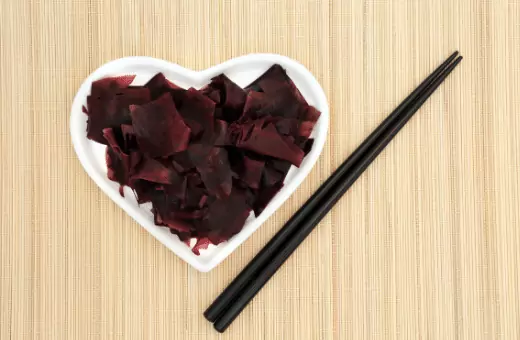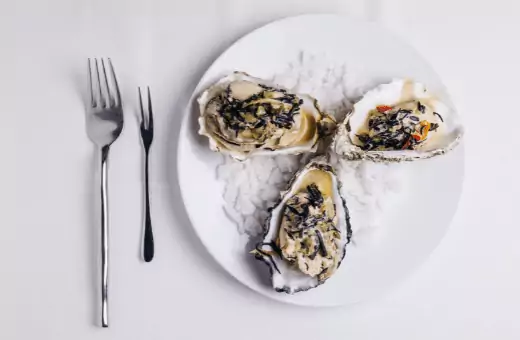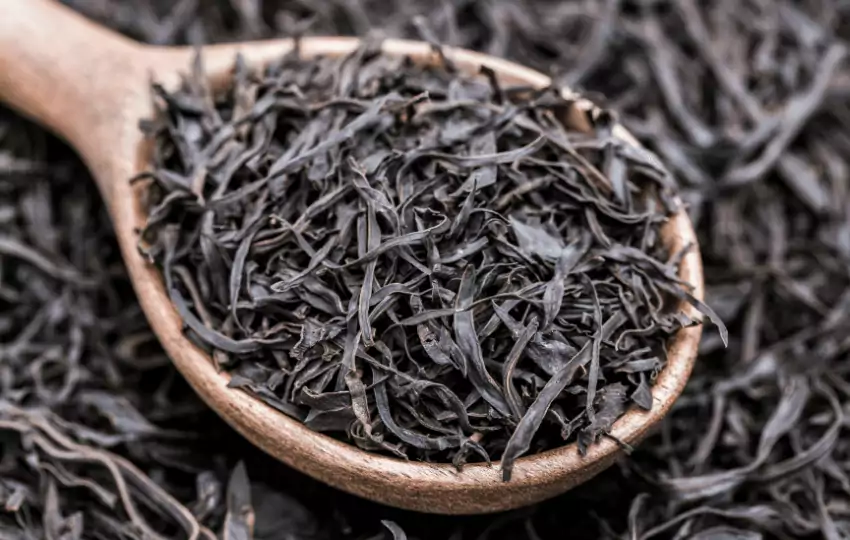If you love sushi, you’re probably familiar with arame seaweed. It’s a type of brown seaweed that has a subtly sweet and nutty flavor.
Though arame seaweed is not readily available in most grocery stores, similar arame seaweed substitutes are similar. All are good and healthy and easily add to soups, salad, sushi, and other dishes.
Like, One of my favorites is dulse seaweed. It has a similar flavor and texture to arame, but it’s even richer in nutrients.
I will explore some of the best substitutes for arame seaweed. Let’s get started!
What type of seaweed is arame?
Arame is a type of seaweed or seaoak that is often used in Asian cuisine. It has mild, dark brown strands, a slightly sweet-earthy flavor, and a firm, chewy texture. It is often used as a topping or garnish on various dishes. It is often used as a wrapping for sushi.
Arema is mostly found in Japanese and Korean cuisine, although, Arame can be found in most Asian markets and some health food stores.
What does arame taste like?
Arame tastes salty and slightly sweet. It is often used in soups and stews, as well as stir-fries.
What has dried arame?
Dried arame is a type of dried seaweed commonly used in Japanese cuisine. It has a mild, slightly sweet flavor and can be used in various dishes, such as soups, stews, and stir-fries. Arame is also a good source of minerals, including iron and calcium.
7 Best Arame Seaweed Substitutes
-Check that the seaweed is properly cleaned and free of debris.
-Give the seaweed a sniff test; it should have a mild, ocean-like smell.
-Make sure the seaweed is pliable and not too brittle.
-If you are using dried seaweed, rehydrate it in water for 10-15 minutes before using.
1. DILLISK / DULSE- Best Arame Seaweed Substitute
Dillisk is a type of edible seaweed found in shallow, coastal waters. It is a rich source of minerals and vitamins. It has been used as a natural remedy for centuries, and it is the most preferable substitute for Arame Seaweed.

Dulse has a long, thin, blackish-brown body with small, round, white, or pinkish tips. The plant is palatable and nutritious, containing high levels of iodine, iron, magnesium, and calcium. It can be eaten raw, cooked, or dried and used as a seasoning.
Dillisk is an excellent source of vitamins A, B, and C and minerals such as potassium and sodium. It is also a rich source of dietary fiber.
Dulse is popular in Iceland as a preferable snack. Dillisk is versatile and well paired with baked cheese, soup, salsa, chowders, sandwiches, and salads, meat dishes.
2. WAKAME- Decent Alternative to Arame Seaweed
Wakame is a type of edible seaweed often used in Japanese cuisine. It has a mild, slightly sweet flavor and can be used in soups, salads, and other dishes.
To substitute wakame for arame seaweed, you will need to soak the wakame in water for about 20 minutes. Once it is soft, you can add it to your dish in place of the arame seaweed.
Remember that wakame will have a milder flavor than arame seaweed, so you may need to adjust your seasoning accordingly. Try best wakame seaweed substitutes.
3. KELP/ KOMBU- Excellent Substitute for Arame Seaweed
As Arame is a type of kelp So, Kelp can be substituted for arame seaweed in many recipes often used in Asian cooking.
Kelp has a similar taste and texture to arame, making it a good recipe replacement. When substituting kelp for arame, use an equal amount of kelp.
Kelp is a type of seaweed rich in iodine and other minerals. It has a strong flavor that can be off-putting to some people.
If you are not used to the taste of kelp, start by using it in small amounts. You can also rinse kelp in cold water before using it to remove some saltiness. Kelp is good in soups, stews, salads, and other dishes. It is also a popular ingredient in sushi rolls.
If you are looking for a recipe that uses kelp, try this Kelp Noodle Salad. This dish is light and refreshing, and it is perfect for a summer picnic. Kelp noodles are a type of noodle made from kelp.
They can be found in the Asian section of most grocery stores. This salad also includes cucumber, carrots, and radishes.
The dressing is made with rice vinegar, sesame oil, and soy sauce.
Kelp can be found in most grocery stores, either in the Asian section or the health food aisle.
4. HIJIKI- Similar to Arame
Try hijiki. Hijiki is a type of brown algae that has a similar texture to arame. It’s often used in Japanese cooking and can be found in Asian markets or online.

It has a strong, salty flavor and is often used in salads or as a topping for rice dishes. Wakame is a type of brown seaweed with a milder flavor than hijiki. It is often used in soups or simmered dishes.
5. Try SEA GRAPE Instead of Arame Seaweed
Suppose you’re looking for a delicious and healthy way to enjoy seaweed. In that case, you should try substituting sea grape for arame seaweed in your next recipe. It has a milder taste than other types of seaweed, making it perfect for those who are new to eating seaweed.
The edible sea grape (Caulerpa lentillifera ) is a green alga in the family Caulerpaceae. It is native to the tropical coasts of the Indo-Pacific region, from India to Japan and Australia.
It grows on coral reefs and in lagoons and is harvested for food in many countries.
The plant is a perennial, meaning it can live for more than two years. It grows rapidly and can reach up to 50 cm (20 in) in length. The stems are hollow, and the leaves are arranged in a whorl around them.
The leaves are oblong or elliptical in shape and have a translucent, grape-like appearance. The plant reproduces by releasing spores, which settle on the seabed and grow into new plants.
The edible sea grape is harvested for food in many countries of its native range, including Japan, known as umibudou, and Hawaii, where it is known as limu kohu.
It is often eaten raw, pickled, or as an ingredient in salads and sushi. In Japan, the plant is also used to make a type of green tea known as umibucha.
The sea grape is a great addition to any diet. It is a good source of vitamins, minerals, and dietary fiber. Seagrape is also low in calories and fat and packed with nutrients like iodine, calcium, and magnesium.
6. NORI- Good Replacement for Arame in Salad and Sushi
A good substitute for arame seaweed is nori. Nori is the most popular seaweed in Southeast Asian Cuisines, a type of red algae commonly used in sushi rolls. It has a milder flavor than arame and is also more versatile in terms of its uses.
You can use nori in wraps, soups, salads, and other dishes where you would normally use arame.
When buying nori seaweed, look for dark green sheets in a color that have a crisp texture. Avoid nori that is yellow or brittle, which indicates that it is old. Nori seaweed can be found in most Asian markets and some health food stores.
Nori seaweed is a healthy and delicious addition to any diet. Try it in sushi, salads, or as a healthy snack. You’re sure to love this versatile seaweed’s unique flavor and health benefits.
7. Try SEA LETTUCE Replace of Arame Seaweed
Sea lettuce (Ulva lactuca) is an edible green seaweed, almost similar to sea oak. It is a green algae found in the intertidal zone in all the world’s oceans. Sea lettuce is rich in vitamins and minerals and has been used as a food source for centuries.
Today, sea lettuce is enjoyed by people all over the world as a healthy and delicious food. It can be eaten raw in salads or cooked in various dishes. Sea lettuce is a great source of vitamins A, C, and E and magnesium, iron, and calcium. It is also high in protein and fiber.
If you are looking for a healthy and delicious way to add more greens to your diet, sea lettuce is a great option. It is easy to find and relatively inexpensive.
Check More Substitutes- Bonito Flakes Substitutes, Healthy SPAM Alternatives
What is the difference between arame and wakame?
Arame is a type of kelp that is common in Japanese cuisine. It has a milder flavor than wakame and is often used in soups and salads. On the other hand, Wakame is a type of seaweed that has a more pronounced salty flavor. It is commonly used in miso soup and sunomono (Japanese vinegar salad).
Arame looks like long, dark green strands, while wakame is shorter and has a brighter green color. Both types of kelp are rich in minerals and vitamins, but wakame is higher in calcium and iron.
Arame is also a good source of iodine. Wakame is often used in salads because it has a milder flavor, while arame is more commonly used in soups due to its stronger flavor.
Wrap Up On Substitute for arame seaweed
Arame has a long history of being used as a food and medicine in Asia. It is now gaining popularity in the West for its health benefits. Arame is a type of seaweed rich in minerals, vitamins, and antioxidants.
It has been shown to improve circulation, reduce inflammation, and boost immunity. Arame is also a good source of iodine, which is important for thyroid health.
There are many other healthy and delicious options available. Brown and red algae are nutritious and have a similar taste and texture to arame. Kelp, dulse, and wakame are also good substitutes. These seaweeds are all rich in nutrients and offer a variety of health benefits.
A good conclusion on a replacement for arame seaweed might discuss the many benefits of this type of seaweed, including its nutritional value and its ability to help with weight loss.
FAQs Related to Arame Seaweed & Its Alternative
1. How do you eat arame?
You can eat arame raw, dry-roasted, or in a number of other ways. It’s good to soak arame in water for about 10 minutes before eating it to soften it up.
You can then add it to salads, stir-fries, soups, or other dishes. Arame has a mild, slightly sweet flavor that goes well with many different foods.
2. Arame seaweed where to buy?
There are many places to buy arame seaweed. You can find it at most health food stores or online.
Buy in bulk to save money, and look for organic options to ensure the highest quality seaweed. Arame can also be grown at home in an aquarium.
3. What is the Japanese arame?
The Japanese arame is a type of kelp that is often used in Asian cuisine. It has a mild, slightly sweet flavor and is often used as a vegetarian or vegan alternative to meat.
Arame is high in iodine and other minerals and is a good source of dietary fiber. It can be found dried or fresh at most Asian markets.
4. What seaweed for seaweed salad?
Many types of seaweed can be used for seaweed salad, such as wakame, kombu, hijiki, and arame.
Each type of seaweed has a unique flavor and texture that can contribute to the overall taste and appearance of the salad. Wakame is a mild-flavored seaweed that is often used in miso soup.
It has a slightly sweet taste and a soft, slippery texture. Kombu is a type of kelp that has a strong umami flavor. It is often used to make dashi, a Japanese soup stock.
Hijiki is a seaweed with a mild, slightly sweet flavor. It has a firm texture and is often used in salads or side dishes. Arame is a seaweed with a mild, sweet flavor and a soft, slippery texture. It is often used in soups or stir-fries.

